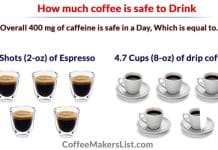When it comes to enjoying a refreshing glass of iced coffee, the secret lies in cold brewing. Forget about the lukewarm and watered-down versions you’ve had before; cold brewing brings out the true essence of coffee with its sweet and smooth flavor. In this article, we will explore the art of brewing iced coffee the right way, unlocking the rich flavors and unique characteristics that make it a beloved beverage for coffee aficionados worldwide. Get ready to tantalize your taste buds as we take you on a journey through the fascinating world of cold brewing.
The Basics of Cold Brewing
What is cold brewing?
Cold brewing is a method of making coffee that involves steeping coffee grounds in cold water for an extended period of time, usually around 12-24 hours. Unlike traditional hot brewing methods, cold brewing extracts the flavors of the coffee beans slowly and gently, resulting in a smooth and less acidic beverage.
Why choose cold brewing for iced coffee?
Cold brewing is the perfect method for making iced coffee because it produces a coffee concentrate that can be diluted and poured over ice without losing its flavor and strength. The slow extraction process of cold brewing allows for the subtle flavors of the coffee beans to come through, resulting in a sweeter and less bitter taste. With cold brewing, you can enjoy a refreshing and flavorful iced coffee without the need for additional sweeteners or additives.
Advantages of cold brewing
There are several advantages to cold brewing compared to traditional hot brewing methods. Firstly, cold brewing produces a coffee concentrate that can be stored in the refrigerator for up to two weeks, allowing you to have a ready-to-drink iced coffee anytime. Additionally, cold brewed coffee is less acidic and bitter, making it easier on the stomach and teeth. It also has lower caffeine content, which is perfect for those who are sensitive to caffeine or prefer a milder pick-me-up. Finally, cold brewing allows you to experiment with different coffee bean types and flavors to create a personalized and unique iced coffee experience.
Equipment and Ingredients
Choosing the right coffee beans
To achieve the best cold brewed coffee, it’s important to start with high-quality coffee beans. Look for beans that have been roasted within the past two weeks, as fresher beans will yield better flavors. Additionally, consider the flavor profile you prefer – a light roast will bring out brighter and fruitier notes, while a dark roast will result in a richer and bolder taste. Experimenting with different coffee bean origins and blends will help you discover your preferred flavors for cold brewing.
Grinding the beans
For cold brewing, it’s recommended to use a coarse grind size. This allows for better extraction and minimizes any bitterness that can result from over-extraction. Invest in a good quality burr grinder to ensure consistent grind size, as a uniform grind is crucial for an even extraction.
Water quality
The water you use for cold brewing plays a significant role in the final taste of your coffee. Ideally, use filtered water to remove any impurities that may affect the flavor. Avoid using distilled or overly mineralized water, as they can result in a flat or harsh taste. The goal is to have clean and fresh water that enhances the natural flavors of the coffee beans.
Selecting the brewing equipment
When it comes to cold brewing, there are various equipment options to choose from. Some popular choices include mason jars, French presses, and dedicated cold brew systems. The key is to find a vessel that can hold the coffee grounds and water while allowing for sufficient space and filtration. Consider the size of the batch you want to make and the ease of cleaning when selecting your brewing equipment.
The Cold Brewing Process
Step 1: Preparing the coffee grounds
Start by measuring out the desired amount of coffee grounds based on the coffee-to-water ratio you prefer. For a strong and flavorful concentrate, a common starting point is a 1:4 ratio of coffee to water. Adjust according to personal preference. Coarsely grind the coffee beans and place them in a brewing vessel of your choice.
Step 2: The brewing time
Once the coffee grounds are in the brewing vessel, add cold water. Stir gently to ensure all the grounds are saturated. Cover the vessel and let the mixture steep at room temperature or in the refrigerator for 12-24 hours. The longer the steeping time, the stronger and bolder the coffee concentrate will be.
Step 3: Filtration and extraction
After the brewing time is complete, it’s time to filter the coffee concentrate to separate the grounds from the liquid. You can use a fine-mesh sieve, a coffee filter, or cheesecloth for this step. Slowly pour the mixture through the filter, allowing the liquid to drip into a clean container. Take care to avoid pressing or squeezing the grounds, as this can result in a bitter taste.
Step 4: Dilution and flavor adjustment
The concentrated coffee you obtained from filtration is now ready to be diluted and enjoyed as iced coffee. Start by adding equal parts water to the coffee concentrate and adjust according to your taste preferences. If desired, add ice cubes or refrigerate the diluted coffee for a cold and refreshing beverage. Feel free to experiment with different flavorings, such as milk, cream, or syrups, to create your perfect cup of iced coffee.
Exploring Different Cold Brewing Methods
Classic immersion method
The classic immersion method is the most common and straightforward way to cold brew coffee. It involves steeping the coffee grounds in water for an extended period of time and then filtering the mixture to obtain the coffee concentrate. This method is highly customizable, allowing you to adjust the coffee-to-water ratio and steeping time to suit your taste preference.
Japanese-style slow drip method
The Japanese-style slow drip method, also known as Kyoto-style brewing, involves a slow and controlled extraction process. It requires a specialized apparatus that uses a drip mechanism to extract the coffee flavors over an extended period. This method produces a milder and smoother coffee concentrate with delicate flavor notes.
Toddy cold brewing system
The Toddy cold brewing system is a popular choice for those who prefer convenience and consistency. It consists of a brewing container and a separate carafe for filtration. With the Toddy system, you can easily make large batches of coffee concentrate and store it in the refrigerator for up to two weeks. This method is known for producing a low-acid coffee with a full-bodied flavor.
Cold brew concentrate
Cold brew concentrate is a versatile option that allows you to customize the strength and flavor of your iced coffee. It is simply a highly concentrated version of cold brewed coffee that can be diluted to your desired taste. Cold brew concentrate is great for on-the-go or for making larger batches that can be stored for longer periods.
The Perfect Ratio and Brewing Time
Finding the ideal coffee-to-water ratio
The coffee-to-water ratio is a crucial factor in determining the strength and flavor of your cold brewed coffee. Start with a 1:4 ratio (1 part coffee to 4 parts water) for a strong concentrate, and adjust from there based on your taste preferences. If you prefer a milder taste, use a 1:5 or 1:6 ratio. Keep in mind that experimenting with different ratios will help you find your perfect balance.
Understanding the importance of brewing time
The brewing time for cold brewing is a matter of personal preference. Steeping the coffee grounds for 12-24 hours will yield a medium to bold coffee concentrate. If you prefer a milder taste, try steeping for a shorter period, while those who prefer a stronger flavor can extend the brewing time. It’s always a good idea to taste the coffee concentrate during the brewing process to determine the right extraction point for your desired flavor profile.
Achieving the Right Flavors and Strength
Experimenting with different coffee bean types
One of the most exciting aspects of cold brewing is the ability to experiment with different coffee bean types and flavors. Try beans from various origins, such as Ethiopia, Colombia, or Brazil, to experience the unique flavor profiles they offer. Lighter roasts tend to bring out floral and fruity notes, while darker roasts provide more robust and chocolatey flavors. Don’t be afraid to mix and match beans to find your perfect blend.
Controlling the strength of your cold brew
If you find your cold brew to be too strong or too weak, there are several ways to adjust the strength to your liking. To weaken the coffee concentrate, simply dilute it with more water. Conversely, if you prefer a stronger brew, reduce the amount of water used for dilution. This flexibility allows you to tailor your iced coffee to suit your personal taste preferences.
Adding flavors and enhancements
While cold brewed coffee is delicious on its own, you can also enhance its flavors by adding various ingredients. You can experiment with adding milk or cream for a creamier taste, or try sweetening it with syrups like vanilla or caramel. For a unique twist, consider adding spices such as cinnamon or cardamom, or even infusing the coffee with flavors like mint or lavender. The possibilities are endless, and you can let your creativity shine when it comes to customizing your cold brew.
Storing and Serving Cold Brewed Coffee
Proper storage to maintain freshness
To keep your cold brewed coffee fresh and flavorful, it’s important to store it properly. Once you’ve diluted the coffee concentrate to your desired taste, transfer it to an airtight container and refrigerate. Cold brew can stay fresh for up to two weeks when stored in the refrigerator. Avoid exposing the coffee to light and heat, as this can affect its taste and quality.
Different serving options
Cold brewed coffee can be enjoyed in various ways. You can pour it over ice for a classic iced coffee, or blend it with ice for a delicious and refreshing cold brew frappe. If you prefer a warmer beverage, you can heat the diluted coffee concentrate on the stove or in the microwave. The versatility of cold brew allows you to adapt it to your mood and the weather, ensuring a delightful coffee experience year-round.
Creating refreshing coffee-based beverages
Cold brewed coffee is a fantastic base for creating a wide range of coffee-based beverages. You can combine it with milk or cream to make a creamy iced latte, or mix it with sparkling water for a refreshing coffee soda. For a sweeter treat, blend it with ice cream or create your own coffee cocktails. The smooth and less acidic nature of cold brew makes it an ideal canvas for experimenting with different flavors and mixing techniques.
Using cold brew in recipes
Cold brewed coffee can be a delightful ingredient in various recipes. It can be used to enhance the flavors of baked goods such as cakes, cookies, and muffins. You can make coffee-infused syrups or use it as a base for homemade coffee ice cream. Cold brew can also be incorporated into marinades or used as a flavoring agent in savory dishes like barbecue sauce or braised meats. The possibilities are endless, and incorporating cold brew into your culinary adventures will surely elevate your dishes.
Health Benefits and Considerations
Reduced acidity and bitterness
One of the main health benefits of cold brewed coffee is its reduced acidity and bitterness compared to hot brewed coffee. Cold brewing extracts the coffee flavors in a way that minimizes the release of certain compounds that contribute to acidity and bitterness. This makes cold brew easier on the stomach and teeth, reducing the risk of acid reflux or tooth enamel erosion.
Lower caffeine content
Cold brewed coffee typically has a lower caffeine content compared to hot brewed coffee. This can be beneficial for those who are sensitive to caffeine or prefer to limit their intake. With cold brew, you can still enjoy the flavor and aroma of coffee without experiencing the jitters or sleep disturbances that can come with higher caffeine consumption.
Choosing organic or single-origin beans
Cold brewing allows you to have more control over the quality of the coffee you consume. Opting for organic coffee beans ensures that you’re not exposed to harmful pesticides or chemicals. Single-origin beans, on the other hand, maintain the unique flavors and characteristics of a specific region, allowing you to enjoy a more authentic and distinct coffee experience.
Health considerations for cold brew enthusiasts
While cold brewing offers several health benefits, it’s important to consume coffee in moderation. Excessive consumption of coffee, even when cold brewed, can lead to side effects such as increased heart rate, anxiety, or insomnia. It’s also worth noting that cold brew can still have an impact on teeth staining, so it’s advisable to rinse your mouth or brush your teeth after enjoying a cup or two.
Tips and Tricks for Homemade Iced Coffee
Experimenting with brewing time and grind size
Feel free to experiment with the brewing time and grind size to achieve your desired flavor profile. A longer brewing time will result in a stronger coffee concentrate, while a shorter time will produce a milder taste. Adjusting the grind size can also impact the extraction process – a coarser grind may yield a smoother taste, while a finer grind can intensify the flavors.
Using filtered water for better taste
Water quality greatly affects the taste of your cold brew, so using filtered water is highly recommended. It helps remove impurities that may alter the flavors and ensures a clean and refreshing taste. If you don’t have access to filtered water, you can use tap water and let it sit in an open container for a few hours to allow any chlorine to dissipate.
Understanding the impact of recipe modifications
When adding ingredients or modifying a cold brew recipe, keep in mind that certain additions can affect the overall taste and strength. For example, adding milk or cream will result in a milder coffee flavor. Sweeteners like sugar or syrups can also mask or alter the natural flavors of the coffee. It’s essential to taste and adjust as you go to achieve the perfect balance of flavors.
Exploring Iced Coffee Trends
Incorporating coffee ice cubes
One popular trend in the world of iced coffee is using coffee ice cubes. Instead of regular ice cubes, freeze leftover cold brew in an ice cube tray and add them to your iced coffee. This allows you to enjoy the full flavor of your coffee without it becoming diluted as the ice melts.
Adding spices and unique flavors
To elevate your cold brew, consider adding spices or unique flavors. Cinnamon, nutmeg, or even a pinch of cayenne pepper can add a warm and spicy kick to your iced coffee. You can also experiment by adding extracts like vanilla or almond for a subtle twist. Don’t be afraid to get creative and explore different flavor combinations!
Combining cold brew with other beverages
Cold brew pairs well with various other beverages, making it perfect for creating innovative and refreshing drinks. You can mix it with lemonade for a tangy and caffeinated twist, or combine it with coconut water for a hydrating tropical treat. For a creamy and indulgent sip, blend it with chocolate milk or make a coffee-infused smoothie. The possibilities are endless, and combining cold brew with other drinks opens up a whole new world of flavors.
Iced coffee variations from around the world
Coffee culture varies from country to country, and exploring iced coffee variations from different cultures can be an exciting experience. Try Vietnamese iced coffee with condensed milk for a sweet and creamy treat, or indulge in an affogato, an Italian delight that combines cold brew with a scoop of vanilla gelato. Research and experiment with international iced coffee recipes to expand your coffee horizons.
In conclusion, cold brewing is a fantastic method to achieve sweet and smooth iced coffee. With the right equipment, quality ingredients, and a little experimentation, you can create a personalized and refreshing cup of cold brew that satisfies your every coffee craving. From choosing the perfect coffee beans to understanding the brewing process and exploring different methods, the world of cold brewing is full of delightful discoveries. So grab your favorite vessel, start cold brewing, and embark on a journey of discovering the perfect cup of iced coffee made right!







































